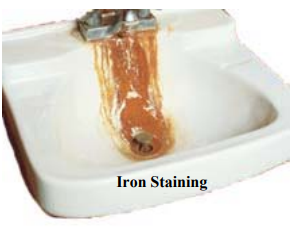Total Iron
View/Download PDF Version
What is Iron?
Iron is a white metallic element, and is the fourth most abundant element in the earth’s crust. Pure iron metal is very reactive and corrodes rapidly when exposed to air. This is why iron is very uncommon in streams and rivers. Dissolved iron that does reach surface water reacts with oxygen to form rust and precipitates out to the bottom of the stream. Dissolved iron is common in groundwater because dissolved oxygen is typically low. When groundwater with dissolved iron is brought to the surface in a well, the iron reacts with oxygen and is converted to visible red rust particles. It is also possible for iron to enter drinking water if it is dissolved from metal pipes.
 Problems With Iron
Problems With Iron
Iron is an essential nutrient in the human diet and does not pose any health risks. In fact, inadequate dietary iron can lead to anemia, a deficiency in the oxygen carrying components of blood. However, high concentrations of iron in water supplies can cause sediment problems in plumbing, metallic taste, and aesthetic problems with red staining of fixtures and laundry. For this reason, the US Environmental Protection Agency (USEPA) has set a secondary standard for iron of 0.3 mg/L. The standard only applies to public water supplies but is a useful guide for private well owners. Manganese can cause similar problems in water supplies. When excess iron or manganese is present, it is usually apparent by the red/orange or brown/black staining the minerals cause.
Iron Bacteria
Another iron related nuisance that can arise is iron bacteria. These bacteria use iron as an energy source and while they do not cause disease, they can cause gelatinous growths that clog pipes, are unattractive, and smell bad. Iron bacteria can be difficult to control effectively if they have colonized the aquifer around a well, but shock chlorination and continuous chlorination works in some cases. For instructions on shock chlorinating a well, see the bacteria fact sheet and instructional video at the MSU Extension Water Quality webpage referenced below.
Treating for Iron
When high iron concentrations are troublesome, the problems tend to show-up in multiple places in the house (washing machines, showers, toilets, and kitchen sinks). For this reason the most common type of treatment is a “point of entry” system which treats all the water entering the house. There are a number of options including sequestration by phosphate feeders, ion-exchange, oxidation filters, chlorinator-and-filter units and oxidation by aeration followed by filtration.
Additional Resources
Click on the links below to be directed to more resources.
MSU Extension Water Quality Program—Drinking Water Initiative (factsheets and videos)
